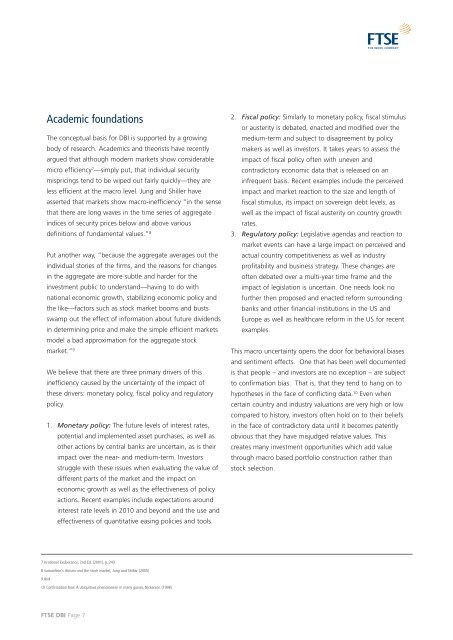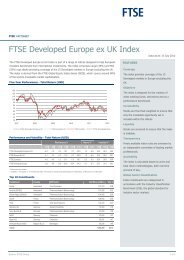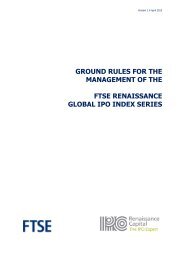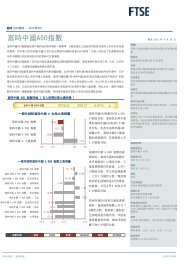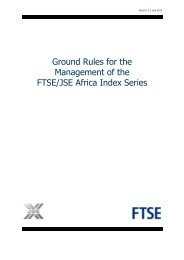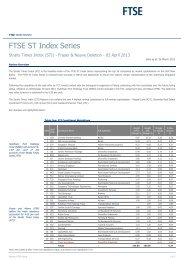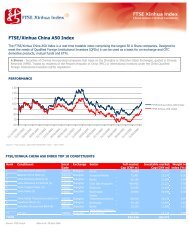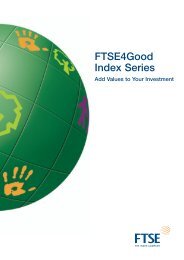QS Investors Diversification Based Investing Whitepaper - FTSE
QS Investors Diversification Based Investing Whitepaper - FTSE
QS Investors Diversification Based Investing Whitepaper - FTSE
You also want an ePaper? Increase the reach of your titles
YUMPU automatically turns print PDFs into web optimized ePapers that Google loves.
Academic foundations<br />
The conceptual basis for DBI is supported by a growing<br />
body of research. Academics and theorists have recently<br />
argued that although modern markets show considerable<br />
micro efficiency7 —simply put, that individual security<br />
mispricings tend to be wiped out fairly quickly—they are<br />
less efficient at the macro level. Jung and Shiller have<br />
asserted that markets show macro-inefficiency “in the sense<br />
that there are long waves in the time series of aggregate<br />
indices of security prices below and above various<br />
definitions of fundamental values.” 8<br />
Put another way, “because the aggregate averages out the<br />
individual stories of the firms, and the reasons for changes<br />
in the aggregate are more subtle and harder for the<br />
investment public to understand—having to do with<br />
national economic growth, stabilizing economic policy and<br />
the like—factors such as stock market booms and busts<br />
swamp out the effect of information about future dividends<br />
in determining price and make the simple efficient markets<br />
model a bad approximation for the aggregate stock<br />
market.” 9<br />
We believe that there are three primary drivers of this<br />
inefficiency caused by the uncertainty of the impact of<br />
these drivers: monetary policy, fiscal policy and regulatory<br />
policy.<br />
1. Monetary policy: The future levels of interest rates,<br />
potential and implemented asset purchases, as well as<br />
other actions by central banks are uncertain, as is their<br />
impact over the near- and medium-term. <strong>Investors</strong><br />
struggle with these issues when evaluating the value of<br />
different parts of the market and the impact on<br />
economic growth as well as the effectiveness of policy<br />
actions. Recent examples include expectations around<br />
interest rate levels in 2010 and beyond and the use and<br />
effectiveness of quantitative easing policies and tools.<br />
7 Irrational Exuberance, 2nd Ed. (2001), p. 243<br />
8 Samuelson’s dictum and the stock market, Jung and Shiller (2005)<br />
9 Ibid<br />
10 Confirmation bias: A ubiquitous phenomenon in many guises, Nickerson (1998)<br />
<strong>FTSE</strong> DBI Page 7<br />
2. Fiscal policy: Similarly to monetary policy, fiscal stimulus<br />
or austerity is debated, enacted and modified over the<br />
medium-term and subject to disagreement by policy<br />
makers as well as investors. It takes years to assess the<br />
impact of fiscal policy often with uneven and<br />
contradictory economic data that is released on an<br />
infrequent basis. Recent examples include the perceived<br />
impact and market reaction to the size and length of<br />
fiscal stimulus, its impact on sovereign debt levels, as<br />
well as the impact of fiscal austerity on country growth<br />
rates.<br />
3. Regulatory policy: Legislative agendas and reaction to<br />
market events can have a large impact on perceived and<br />
actual country competitiveness as well as industry<br />
profitability and business strategy. These changes are<br />
often debated over a multi-year time frame and the<br />
impact of legislation is uncertain. One needs look no<br />
further then proposed and enacted reform surrounding<br />
banks and other financial institutions in the US and<br />
Europe as well as healthcare reform in the US for recent<br />
examples.<br />
This macro uncertainty opens the door for behavioral biases<br />
and sentiment effects. One that has been well documented<br />
is that people – and investors are no exception – are subject<br />
to confirmation bias. That is, that they tend to hang on to<br />
hypotheses in the face of conflicting data. 10 Even when<br />
certain country and industry valuations are very high or low<br />
compared to history, investors often hold on to their beliefs<br />
in the face of contradictory data until it becomes patently<br />
obvious that they have misjudged relative values. This<br />
creates many investment opportunities which add value<br />
through macro based portfolio construction rather than<br />
stock selection.


